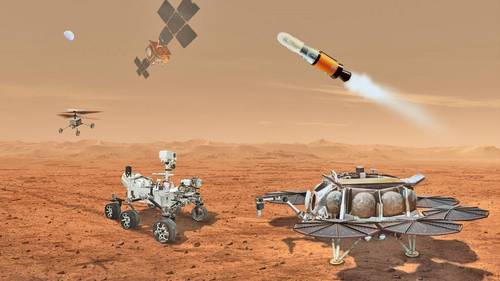An illustration of several robots working together to transfer materials back to Earth from Mars that the NASA Mars Perseverance rover has retrieved.
picture provided by the US space agency
Madrid. The US space agency announced in a statement that the review of system requirements for its Mars-to-Earth sample transfer mission, which is almost finished with the conceptual design phase, has been completed.
The NASA rover Perseverance is now gathering samples at the Jezero crater of the Red Planet. During this phase, the mission team has assessed and improved the architecture to transfer the scientifically chosen rocks.
ESA and NASA
It is anticipated that the campaign’s design, which incorporates contributions from the European Space Agency (ESA), will lessen the complexity of upcoming missions and raise their chances of success.
Every component of a mission plan is scrutinized in detail during the conceptual design stage.
Thomas Zurbuchen, an assistant administrator for science at NASA’s Washington headquarters, stated.
The recent triumphs of Perseverance in Jezero and the outstanding performance of the helicopter Mars, he said, “have resulted in some substantial and positive revisions in the strategy.”
contemporary mission architecture
The longevity of Perseverance, which will serve as the main means of delivering supplies to NASA’s Model Recovery Lander carrying the Mars Ascent Vehicle and ESA’s Sample Transfer Arm, has recently undergone an updated analysis. This updated analysis is taken into account by the sophisticated mission architecture.
The Sample Fetch Rover and its companion second lander will no longer be a part of the Mars Sample Return campaign. Two sample recovery helicopters will be part of the Sample Retrieval Lander and will be based on the design of Ingenuity, which made 29 flights to Mars and endured for a period of time longer than expected. According to NASA, the helicopters will offer a backup option to retrieve samples that have been left behind on Mars’ surface.
The capture, containment, and return mechanism provided by NASA and the Earth Return Orbiter by ESA continue to be crucial components of the program’s architecture.
The Earth Return Orbiter and Sample Retrieval Lander are scheduled to launch in the fall of 2027 and the summer of 2028, respectively, and are anticipated to arrive on Earth in 2033.
The program is anticipated to enter its preliminary design phase in October of next year after its architecture has been solidified during this conceptual design phase. This phase, which is anticipated to last for around a year, will finish technological development and produce engineering prototypes of the mission’s essential parts.
The 22 member states of Terrae Novae, Europe’s space exploration program, were presented with this improved Mars Sample Return campaign idea in May. The states will talk about stopping the Sample Fetch Rover’s development at their upcoming conference in September.
The Earth Return Orbiter, which will make the historic round trip from Earth to Mars and back, and the Sample Transfer Arm, which will robotically affix sample tubes to the orbiting container before to launch from the surface of the Red Planet, are both being developed by ESA at top speed.
David Parker, the ESA’s director of human and robotic exploration, was exposed.
The various contributions to the campaign rely on the funding provided by the ESA and the participating US states. The next year, agreements between the two agencies will be set up.
Working together on historic projects like Mars Sample Return not only yields priceless information about our place in the cosmos, but also strengthens our bonds with one another here on Earth.
Zurbuchen gave his word.
The Mars sample transfer campaign has already started with its first phase. The rover Perseverance has acquired 11 scientifically sound rock core samples and one atmosphere material since touching down in Jezero Crater on February 18, 2021.
Bringing samples from Mars to Earth would enable researchers from all around the world to study them using sophisticated equipment that is too large and complex to go to Mars.
